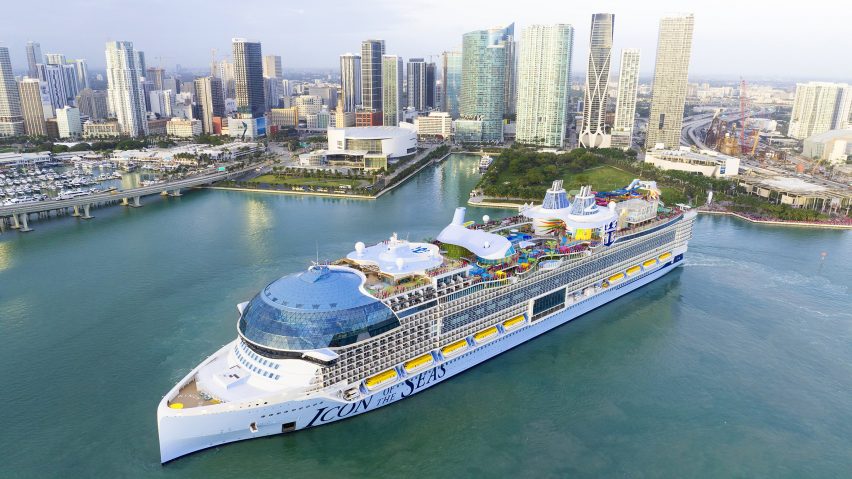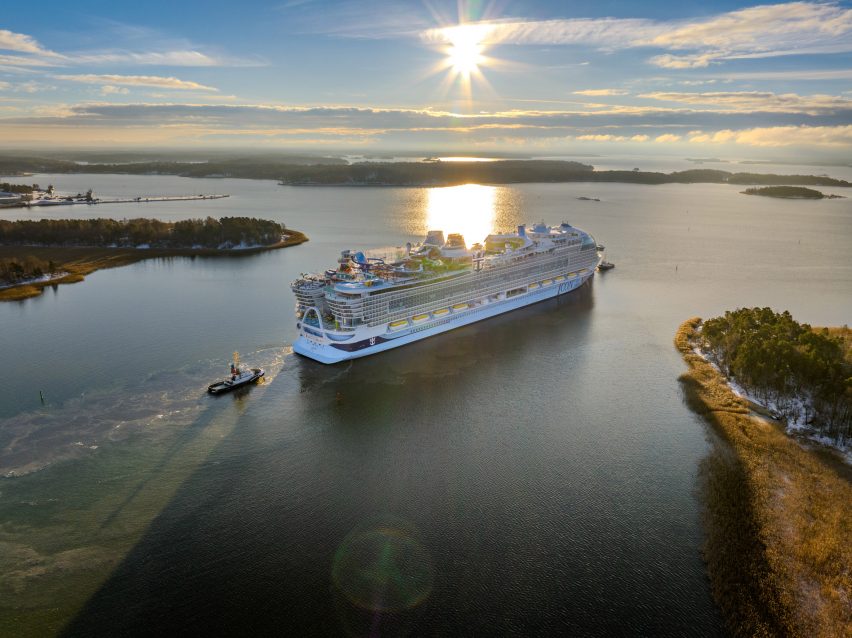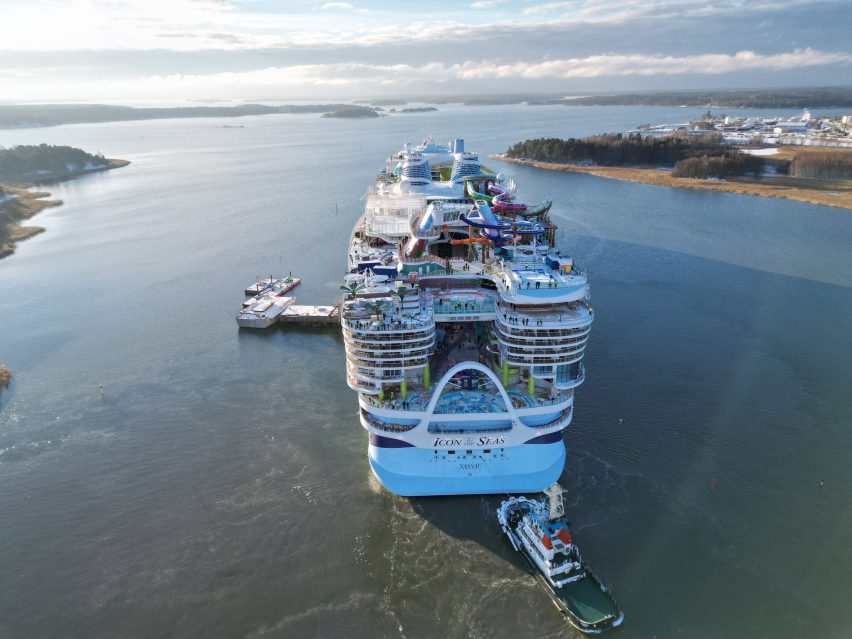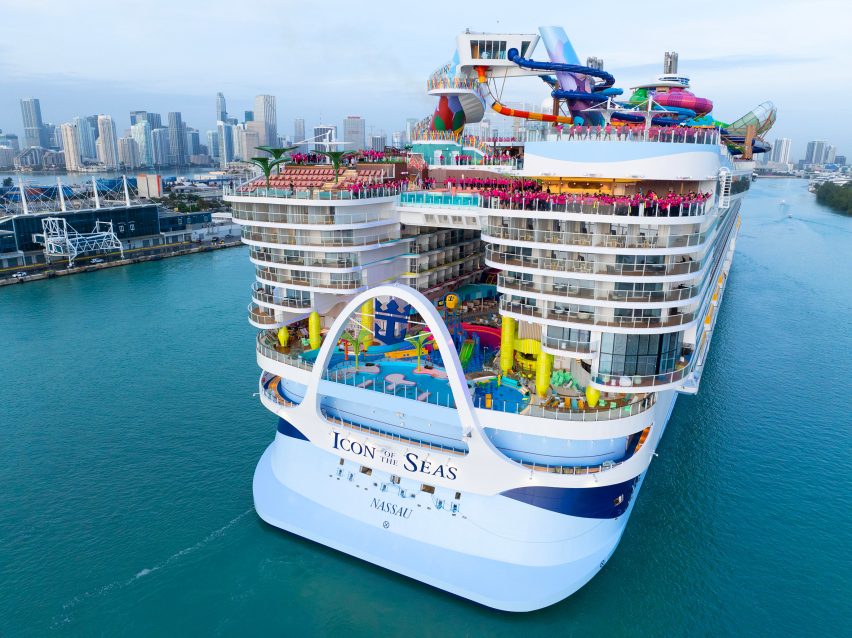
World's largest cruise ship sets sail amid sustainability concerns
Royal Carribbean's near-10,000-capacity Icon of the Seas has set sail on its maiden voyage amid controversy over the environmental impact of its new fuel.
The 20-deck-high Icon of the Seas, which is the world's largest cruise ship, set off from Miami on Saturday, headed on its first cruise in the Caribbean.
Designed with contributions from Skylab Architecture, Wilson Butler Architects, 3Deluxe and RTKL, the ship weighs 248,663 gross tonnes – around five Titanics – and has room for 7,600 guests and 2,350 crew.

Onboard are 2,805 cabins, seven pools, the world's largest ship-based waterpark and eight separate "neighbourhoods" that are home to restaurants, bars and entertainment.
There are also two tanks of liquified natural gas (LNG) — a first-time fuel source for Royal Carribbean, which has called it "the cleanest fossil fuel available" and the Icon of the Seas its "most sustainable ship yet".
However, critics have said the cruise line has failed to include methane leakage from the new fuel system in its emissions calculations.
The use of LNG, also known as methane, cuts down on dangerous pollutants like sulfur and nitrogen oxides, and is estimated to produce about 30 per cent less carbon dioxide emissions than the heavy fuel oils currently used in cruise ships. However, not all of the gas is successfully burned during use — some of it always escapes into the atmosphere.

Because methane is considered worse than carbon dioxide for the atmosphere over the short term – it breaks down faster, but it is about 80 times more potent over a 20-year-period – it's estimated that the switch could be overall worse for greenhouse gas emissions.
"They are doubling down by calling LNG a green fuel when the engine is emitting 70 to 80 per cent more greenhouse gas emissions per trip than if it used regular marine fuel," International Council of Clean Transportation (ICCT) marine programme director Bryan Comer told the Guardian.
"Icon has the largest LNG tanks ever installed in a ship. It is greenwashing."
The ICCT released a report about methane emissions from LNG-fuelled ships on January 25, two days before the Icon of the Seas set sail.
For its part, Royal Carribbean says that LNG will be a "transitional fuel" on the way to its first net-zero cruise ship, which it plans to introduce by 2035.
The Icon of the Seas has a dual-fuel engine so it can use both diesel and LNG, and among the other energy-saving initiatives on board is the first waste-to-energy plant to operate at sea.
Royal Carribbean has pitched the Icon of the Seas as a "multigenerational family holiday", with CEO and president Michael Bayley describing it as a "a one-of-a-kind vacation for every type of family and adventurer".

Constructed at the shipyard of Meyer Turku in Finland over five years, the vessel was built in "grand blocks" that Royal Carribbean said were assembled like Lego.
Among its six waterslides is one that cantilevers over the ocean, while its seven pools include a suspended infinity pool.
Its eight neighbourhoods include "Thrill Island", which is home to waterparks and a "Crown's Edge" adventure described as "part skywalk, part ropes course and part thrill ride on which adventurers swing 154 feet above the ocean".
There is also Chill Island with its pools, Central Park with its greenery and open air, and the AquaDome entertainment complex, said to be the largest glass and steel structure to be lifted onto a cruise ship.
The 365-metre-long Icon of the Seas went viral when its renders were revealed last year, showing a teeming mass of people, cabanas and colourful slides.
One X user compared it to a Hieronymus Bosch painting and another to "the Candy Crush version of the dystopian underground world in Silo".
Cruise lines have been under pressure to switch from petroleum, with research suggesting that a large cruise ship can have a carbon footprint greater than 12,000 cars.
A perhaps more promising effort at sustainable shipping came last year from the Mitsubishi Corporation, which retrofitted a cargo ship with sails so it could be powered by wind.